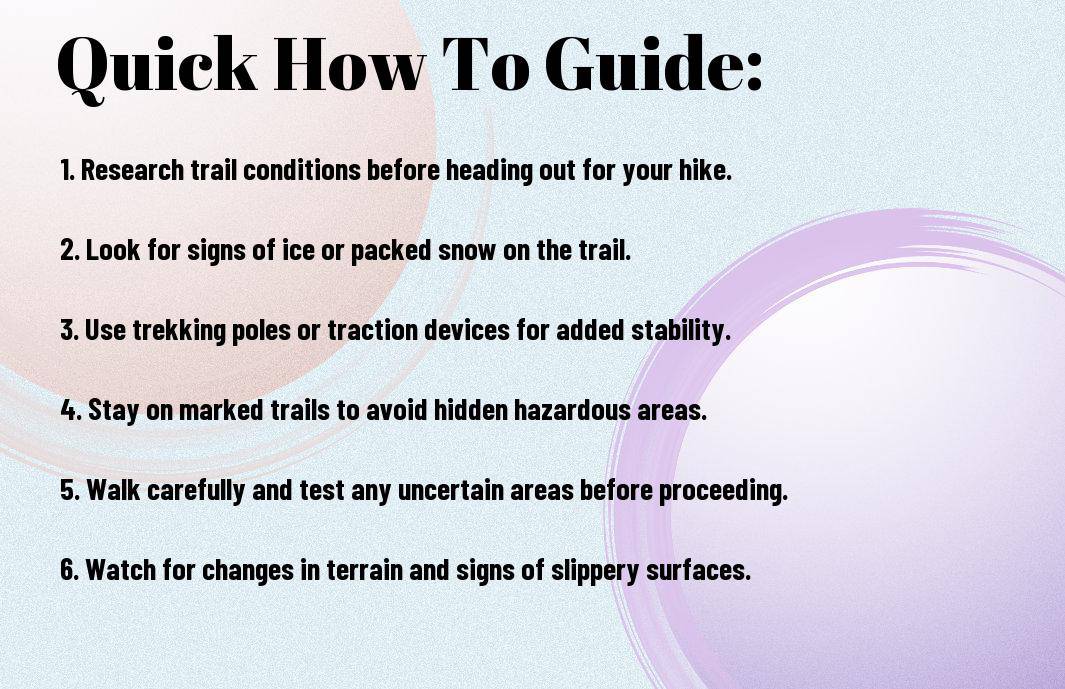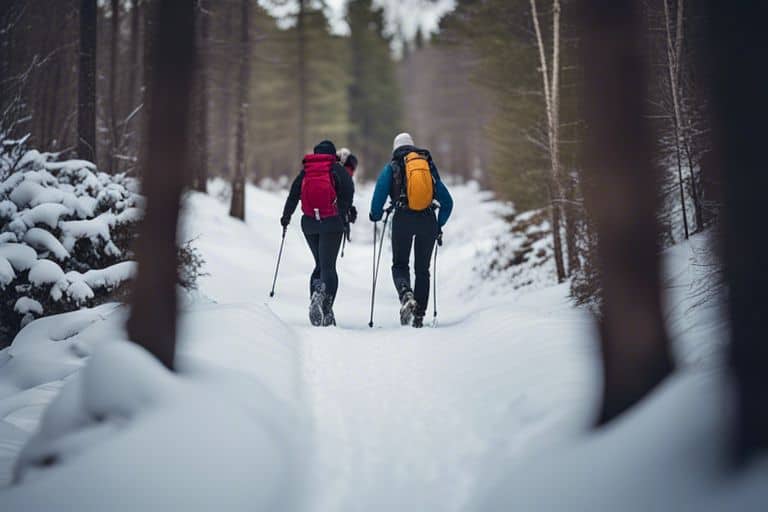You may think that winter hiking is not as risky as it seems, but potential slippery areas can pose a serious threat to your safety. It’s crucial that you are able to identify and avoid these hazardous spots, so you can enjoy your winter hike without the fear of slipping and getting injured. Here are some important tips to help you stay safe on winter hiking trails.
One of the key strategies for avoiding slippery areas on winter hiking trails is to look for signs of ice and snow accumulation. Pay attention to shaded areas, where ice is more likely to linger, and be especially cautious around bodies of water or areas with running water, as they can create icy patches. Additionally, keep an eye out for packed snow and uneven surfaces, as these can also increase the risk of slipping. By staying aware of your surroundings and actively identifying these potential hazards, you can take the necessary precautions to avoid them and ensure a safe and enjoyable winter hike.
Key Takeaways:
- Be aware of weather conditions: Keep an eye on the weather forecast and be prepared for potential ice or snow on the trails.
- Watch out for shaded areas: Shaded areas tend to retain ice and snow longer, so be cautious when hiking through these spots.
- Use proper footwear: Invest in quality traction devices, such as crampons or microspikes, to improve grip on slippery terrain.
- Slow down and take your time: Avoid rushing through icy or snowy areas, take smaller steps and maintain balance to prevent slipping.
- Stay informed and prepared: Educate yourself about potential hazards and always carry necessary safety equipment, such as trekking poles and a first aid kit.


Assessing the Terrain Before Your Hike
Any experienced hiker will tell you that having a good understanding of the terrain before you set out on a winter hike is crucial for safety. By properly assessing the trail conditions and considering weather factors, you can identify and avoid potential slippery areas, reducing the risk of accidents and injuries.
Tips for Evaluating Trail Conditions
When evaluating trail conditions, there are a few key factors to keep in mind. Look for recent weather patterns, such as snowfall or ice accumulation, which can greatly impact trail slipperiness. Check for any visible signs of ice, such as frost or frozen ground, especially in shady or low-lying areas. Assess the steepness and exposure of the terrain, as these can affect the likelihood of icy or slippery patches. Consider the type of trail surface – packed snow and ice can be more treacherous than rougher terrain with better traction. Wearing appropriate footwear with traction devices, such as crampons or ice cleats, can greatly reduce your risk of slipping. The use of trekking poles can also provide added stability and support on slippery surfaces. The more thoroughly you evaluate these conditions, the better equipped you will be for your winter hike.
Weather Factors That Affect Trail Slipperiness
Weather plays a significant role in trail conditions and slipperiness. Temperature fluctuations can cause melting and refreezing of snow and ice, leading to particularly slick conditions. Precipitation, whether it be snow, sleet, or freezing rain, can create hazardous surfaces. Additionally, wind can impact trail conditions by blowing snow or moisture onto the path, adding an extra level of slipperiness. Keep an eye on the forecast and be prepared to adjust your plans based on the weather conditions. The more aware you are of the potential impacts weather can have on the trail, the better you can anticipate and avoid slippery areas.
How to Interpret Trail Markers and Signs
To ensure a safe and enjoyable winter hiking experience, it’s crucial to interpret trail markers and signs correctly. These indicators provide valuable information that can help you navigate the trail and avoid potential hazards. Understanding the meaning of these markers and signs is essential for your safety and the preservation of the environment.
Reading and Understanding Common Trail Markings
Trail markings are designed to provide you with essential information about the trail, including direction, distance, and difficulty level. Common trail markings include blazes, cairns, and painted symbols on trees or rocks. Blazes are colored marks on trees or rocks that indicate the trail’s direction. They are typically found at eye level, and their color and shape may vary depending on the trail. Cairns are man-made piles of rocks that serve as trail markers, particularly in areas with limited visibility. Understanding these common trail markings will help you stay on the designated trail and avoid getting lost in unfamiliar territory.
The Role of Trail Signs in Identifying Hazardous Areas
Trail signs are another essential component of interpreting potential hazards on winter hiking trails. These signs provide crucial information about dangerous areas, such as steep inclines, slippery terrain, and potential avalanche zones. Pay close attention to signs that warn of hazardous conditions and adjust your hiking plan accordingly. Ignoring these signs could put you at risk of injury or worse, so always respect and heed their warnings. Trail signs also offer valuable guidance on trail etiquette, wildlife awareness, and environmental protection. By understanding the role of trail signs, you can effectively navigate the trail and ensure a safe and responsible hiking experience.
The Right Gear for Winter Hiking
Not all gear is created equal when it comes to winter hiking. The right equipment is essential for ensuring your safety and comfort on the trails. Before you set out, it’s important to consider the specific challenges posed by winter conditions and choose your gear accordingly.
Footwear Choices to Maximize Traction
When it comes to winter hiking, your footwear can make all the difference in maintaining your stability on slippery surfaces. Investing in a good pair of insulated, waterproof boots with a deep tread will provide you with the traction you need to navigate icy and snowy trails. Look for boots with ankle support to help prevent twisting or rolling your ankle on uneven terrain. Additionally, consider adding ice cleats or traction devices to your boots for added grip on icy surfaces. These simple additions can significantly increase your stability and confidence while hiking in winter conditions.
Essentials for Increasing Stability on Slippery Surfaces
Aside from the right footwear, there are a few essential items that can further increase your stability on slippery surfaces. Hiking poles or trekking poles are invaluable for providing additional support and balance, especially when navigating steep or uneven terrain. These poles can also help you test the stability of the ground ahead of you and provide an extra point of contact to prevent slips and falls. Additionally, consider carrying gaiters to keep snow out of your boots and prevent it from melting and making your feet wet, which could lead to cold and potentially dangerous conditions.
How-to Identify Slippery Areas in Advance
For avid hikers, navigating slippery terrain during the winter months can present a real challenge. Identifying potential slippery areas in advance can help you to plan your route more effectively and avoid unnecessary risks. In this chapter, we’ll discuss some visual and physical indicators to watch out for when assessing the trail conditions before you set out on your winter hike.
Visual Indicators of Potentially Slippery Surfaces
When assessing a winter hiking trail, it’s important to be vigilant for visual indicators that may signal potentially slippery surfaces. Keep an eye out for icy patches, wet leaves, or standing water on the trail. Shaded areas where the sun doesn’t reach as easily are more likely to have icy patches, so be cautious when approaching these spots. Additionally, examine the terrain closely for any frost or ice crystals on the ground or on rocks. These could be indicative of slippery conditions and should be approached with caution.
Physical Factors to Consider When Hiking
Physical factors such as the slope and elevation of the trail can greatly impact the likelihood of encountering slippery areas. Generally, steeper slopes increase the risk of encountering ice and snow build-up. High-altitude trails are also more prone to icy conditions due to lower temperatures, so be sure to take this into account when planning your hike. Additionally, take into consideration the type of terrain you’ll encounter. Densely forested areas may have icy patches that are hidden beneath fallen leaves, while exposed rocky surfaces can become slick with ice. The recent weather conditions also play a crucial role in determining the level of slipperiness. The presence of recent snow or freezing rain can significantly elevate the risk of encountering slippery surfaces.
- Slope and elevation of the trail
- High-altitude trails
- Type of terrain
- Recent weather conditions
The importance of being aware of visual indicators and physical factors cannot be overstated. The presence of icy patches, wet leaves, and standing water on the trail, combined with steep slopes, high elevation, and recent adverse weather conditions, significantly increases the risk of encountering slippery areas. Knowing how to identify these potential hazards in advance is crucial for keeping yourself safe during winter hiking trips.
Techniques for Safely Navigating Slippery Trails
Unlike regular hiking, traversing slippery winter trails requires different techniques to ensure your safety. With the right skills, you can enjoy a winter hike without worrying about falling. For more outdoor tips, you can also check out this article on Wet Weather & Winter OUTDOOR Tips.
Body Positioning and Balance Tips
When hiking on slippery trails, it’s crucial to maintain proper body positioning and balance. Keep your center of gravity low, and shift your weight as needed to maintain stability. Engage your core muscles to help you stay upright. Make sure to take small, deliberate steps, and avoid making sudden movements that may throw off your balance. Use trekking poles to help you with balance and to test the stability of the trail before committing your weight to each step. Knowing how to use your body effectively will help prevent slips and falls.
Adjusting Your Pace and Gait on Icy or Snowy Terrain
When hiking on icy or snowy terrain, it’s essential to slow down your pace and adjust your gait. Take shorter steps to improve your stability and avoid overstriding, which can lead to slipping. Keep your feet parallel and shoulder-width apart to maintain a solid base of support. It’s also helpful to walk with a slight bend in your knees, which can absorb the impact of each step and reduce the risk of slipping. By making these adjustments, you’ll be able to maintain better control as you navigate through the winter wilderness.
Avoiding Common Mistakes on Winter Trails
Your safety on winter trails depends on your ability to avoid common mistakes that can lead to slips, falls, and other accidents. By understanding these mistakes and taking specific precautions, you can enjoy winter hiking with greater confidence and peace of mind.
Overestimating Grip and Traction
One of the most common mistakes hikers make on winter trails is overestimating the grip and traction of their footwear. While some boots advertise excellent traction, ice and compacted snow can still be extremely slippery, even with the best equipment. It’s important to be prepared with additional traction devices such as micro-spikes or crampons, especially if you will be encountering icy or steep terrain. By relying solely on your boots, you put yourself at risk of slipping and injuring yourself.
Ignoring Natural Warning Signs and Pathway Alterations
Another mistake to avoid is ignoring natural warning signs and pathway alterations. In winter, trails can be obscured by snow and ice, leading to potential hazards such as hidden drop-offs, unstable surfaces, or potential avalanche zones. Ignoring these warning signs, marked or unmarked, can lead to dangerous situations. It’s important to pay attention to any signage or warnings provided by park rangers and to use common sense when traversing winter trails. Always stay on marked pathways and avoid venturing into unknown or off-limits areas.
Conclusion
With these considerations in mind, you should feel more confident in identifying and avoiding potential slippery areas on winter hiking trails. By paying attention to the terrain, staying aware of weather conditions, and utilizing the right gear, you can reduce the risk of slips and falls. Remember to always prioritize safety and be prepared for unexpected hazards, such as ice and snow. As you continue to explore winter hiking trails, staying cautious and proactive will help ensure a safe and enjoyable outdoor experience.
Winter Hiking: Identifying and Avoiding Potential Slippery Areas
Q: What are potential slippery areas on winter hiking trails?
A: Potential slippery areas on winter hiking trails include icy patches, compacted snow, and areas with hidden ice under a thin layer of snow. These areas can increase the risk of slipping and falling.
Q: How can I identify potential slippery areas on winter hiking trails?
A: Look for signs of ice and compacted snow, such as a shiny or smooth surface. Pay attention to the temperature and recent weather conditions, as well as any shaded areas where ice is more likely to form.
Q: What precautions can I take to avoid slippery areas on winter hiking trails?
A: Wear traction devices such as crampons or microspikes on your boots to improve grip on slippery surfaces. Use trekking poles for added stability and to test the firmness of the ground before stepping on it.
Q: How should I adjust my hiking technique to navigate potential slippery areas?
A: Take shorter steps and maintain a wider stance to improve balance. Be mindful of your footing and try to walk on the most stable and textured surfaces, such as rocks or dry patches of snow.
Q: What should I do if I encounter a particularly treacherous section of trail?
A: If you come across a section of the trail that seems dangerously slick, consider turning back or finding an alternative route. It’s better to err on the side of caution than risk injury. If necessary, use a rope or safety harness for added security.



0 Comments